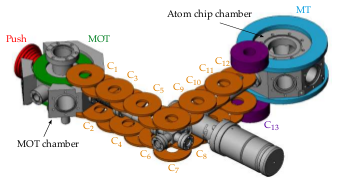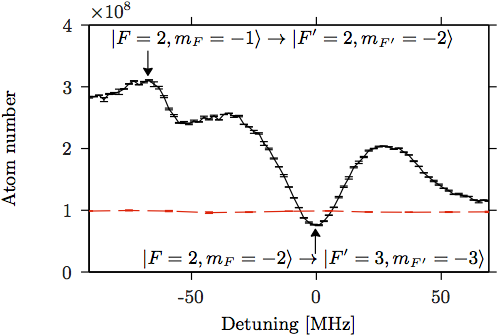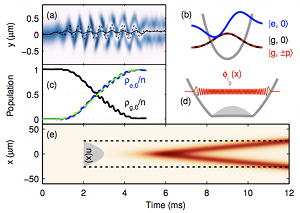News from the sodium chip lab will be posted on this page! |
|
 The magnetic coils arrangement for atom transport. |
Comparison of time profiles for the magnetic transport of cold atomsWe have compared different time profiles for the trajectory of the centre of a quadrupole magnetic trap designed for the transport of cold sodium atoms. Our experimental observations show that a smooth profile characterized by an analytical expression involving the error function minimizes the transport duration while limiting atom losses and heating of the trapped gas. Using numerical calculations of single atom classical trajectories within the trap, we show that this observation can be qualitatively interpreted as a trade-off between two types of losses: finite depth of the confinement and Majorana spin flips. See the publication
|
 Red: atom number in the MOT without the pumping stage. Black: with pumping, as a function of the pumping frequency. |
Detailed study of a transverse field Zeeman slowerWe present a thorough analysis of a Zeeman slower for sodium atoms made of permanent magnets in a Halbach configuration. Due to the orientation of the magnetic field, the polarisation of the slowing laser beam cannot be purely circular leading to optical leakages into dark states. To circumvent this effect, we propose an atomic state preparation stage able to significantly increase the performances of the Zeeman slower. After a careful theoretical analysis of the problem, we experimentally implement an optical pumping stage leading to an increase of the magneto-optical trap loading rate by 3.5, see figure. Such method is easy to set up and could be extended to other Zeeman slower architectures. See the publication
|
In collaboration with Vienna: |
|
 |
Dynamics of parametric matter wave amplificationWe develop a model for parametric amplification, based on a density matrix approach, which naturally accounts for the peculiarities arising for matter waves: significant depletion and explicit time-dependence of the source state population, long interaction times, and spatial dynamics of the amplified modes. We apply our model to explain the details in an experimental study on twin-atom beam emission from a one-dimensional degenerate Bose gas. Work in collaboration with the Vienna group. See the publication
|
 |
Hanbury Brown and Twiss correlations across the Bose-Einstein condensation thresholdHanbury Brown and Twiss correlations, i.e. correlations in far-field intensity fluctuations, yield fundamental information on the nature of light sources, as highlighted after the discovery of photon bunching. Drawing on the analogy between photons and atoms, comparable observations have been made studying expanding Bose gases. We have used two-point density correlations to study how matter-wave coherence is established when crossing the Bose-Einstein condensation threshold. Our experiments reveal a persistent multimode character of the source, also significantly below the condensation threshold temperature. Complex quantum correlations are observed for a variety of source geometries, from quasi-isotropic to highly elongated. Ideal Bose gas theory reproduces most of the qualitative features of our measurements, however a quantitative analysis highlights the need for a more comprehensive theoretical description including particle interactions. Work in collaboration with the Vienna group. See the publication
|